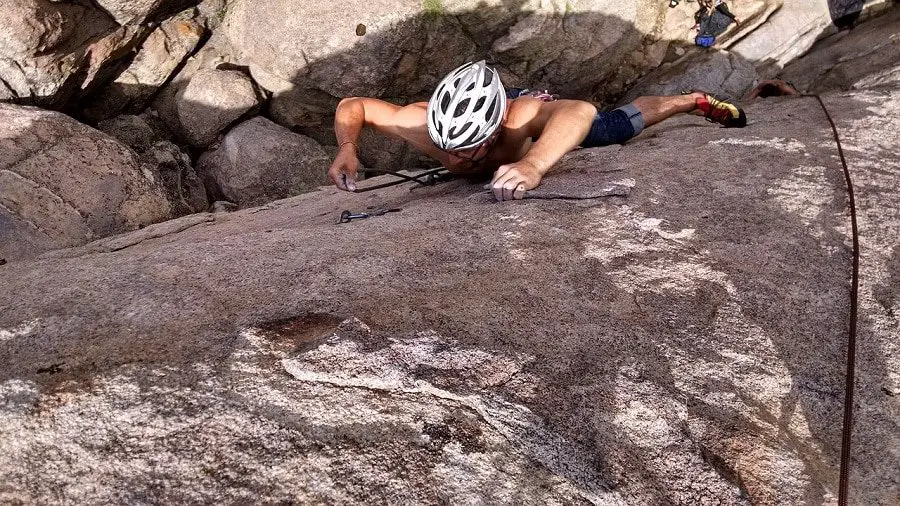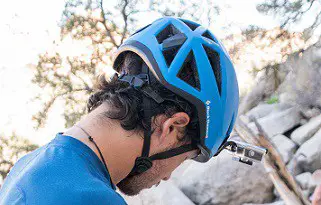Disclosure: Links marked with * are Affiliate Links. As an Amazon Associate, I earn from qualifying purchases if you decide to make a purchase through these links – at no cost for you!

As a beginner, you are often faced with the problem of not owning every part of an ideal climbing equipment. This is especially noticeable if you have only been in a climbing hall and now want to go outside.
An important piece of equipment that is not needed in a climbing hall is the climbing helmet. Outside at the crag, however, a helmet is important to avoid being injured by stones falling down randomly. If you want to go climbing outdoors spontaneously and don’t have a climbing helmet, but a bicycle helmet, you might ask yourself:
Can I use my bicycle helmet for climbing? The short answer is no, but it´s better than nothing. The two different types of helmets were designed for different conditions.
The bicycle helmet is ideal for a one-time protection of the head with a fall of the bicycle. The climbing helmet protects the head more effectively against rockfall and is still intact after a blow or a drop. Because of that, you are still protected until you reach the ground again.
I will explain the exact difference between the two types of helmets in the first part of this article. In the end, I will introduce you to some good helmets for little money. Maybe you still have enough time before your climbing trip to order a low-priced helmet at Amazon*.
The Difference between a Bicycle Helmet and a Climbing Helmet
Bicycle helmets and climbing helmets are designed for different impact forces. Outside of their actual function, they do not offer optimal protection.
Like cars, bicycle helmets are designed to collapse in a collision and absorb the energy of the impulse. And they only have to protect the head once – after the crash, they are broken. Usually, the danger is over after a bicycle accident and no further protection is needed.
Climbing helmets have to withstand several collisions. They are not designed like bicycle helmets and do not crumple in a collision. But they offer longer protection because you can’t stop climbing just because you had an accident. If you are in the middle of a climbing route and are hit on the head with a big stone, you still have to get down somehow. Climbing helmets are mainly designed to withstand several collisions. Especially from falling stone and not so much to break a fall to the ground or against a wall. If a climbing helmet could only withstand a single impact like a bicycle helmet, you would no longer be protected for the rest of the climbing.
So if you would wear a bicycle helmet for climbing and there would actually be an accident in which you hit your head against the wall and the bicycle helmet suffers damage, it would no longer offer good protection against falling rocks.
Safety Standards for Bicycle Helmets and Climbing Helmets
As already mentioned, the requirements for bicycle helmets and climbing helmets cannot be compared very well. Nevertheless, the individual standards and requirements of the respective helmet types are listed below.
Bicycle Helmets
- US: CPSC
Before the durability test, the bicycle helmet is artificially aged. It is exposed to cold and hot temperatures and immersed in water. Then a 5 kg artificial head is equipped with the bicycle helmet to be tested. It is then dropped twice from a height of 2 m onto a solid flat surface and twice from a height of 1.2 m onto a round and once onto a square metal body. The impact may not exceed 300 g in strength.
- EU: EN 1078
With this standard, the helmet is dropped from a height of one and a half meters once onto a flat surface and once onto a square, a massive object with a maximum acceleration of 250 g. The helmets are first aged by temperature and UV radiation.
Climbing Helmets
- EU: EN 12492
A 5 kg heavy object is dropped onto the climbing helmet. This is repeated from all sides, i.e. from the front, rear and both sides. To test the resistance against pointed rocks, a pointed striker weighing 3 kilograms is dropped from a height of one meter onto the helmet. The helmet has passed the tests if none of these impacts have transmitted a force higher than 10 kilonewtons.
- US: UIAA 106
The only difference between the UIAA 106 and the European EN 12492 is that the impacts may only transmit a force of 8 kilonewtons to the head.
If you take a closer look at the different tests between bicycle helmets and climbing helmets, you will soon notice that it is actually the other way around. Some climbing helmets can be used for cycling, but bicycle helmets cannot be used for climbing because they are single-use.
Good and Inexpensive Climbing Helmets for Beginners
If you are sure that you need a climbing helmet, I have listed some very good climbing helmets that are especially suitable for beginners and can be delivered quickly by Amazon.

Related Post:
How to Choose a Rock Climbing Helmet
Inexpensive: Black Diamond Half Dome
The Black Diamond Half Dome is great for beginners in terms of price and durability. The hard shell makes the helmet very stable, but also a little heavier than helmets with lighter constructions. If you don’t mind the relatively high weight, the Black Diamond Half Dome will last forever.
Pros:
- Affordable
- Robust
- Easy to adjust
- Comfortable to wear
- Version for women available
Cons:
- Relatively heavy
- Poor ventilation
Safe: Petzl Boreo
You can hardly climb safer than with the Petzl Boreo. The three layers of different foams perfectly secure the head in a very compact shape.
Pros:
- Extremely safe
- Relatively inexpensive
- Very suitable for headlamps
Cons:
- Chinstrap poorly adjustable
Pro: Mammut Wall Rider
If you want the best quality directly, you can’t ignore the Mammut Wall Rider. This helmet brings everything you could wish for in a climbing helmet. Usually, you have to cut back on design, ventilation or comfort when the safety is in focus. But not with the Mammut Wall Rider.
Who already knows that he will use his new helmet frequently, should really take a closer look at this helmet. The only disadvantage is, of course, that you can see all these advantages compared to other helmets in its price.
Pros:
- Secure
- Lightweight
- Comfortable
- Good ventilation
- Very well adjustable
Cons:
- Relatively expensive
Conclusion
Bicycle helmets and climbing helmets are different from each other in their function to protect the head. Therefore you should always choose the right helmet for the right activity. Bicycle helmets are designed to absorb a single heavy fall. Climbing helmets, on the other hand, have to withstand several impacts to protect the climber until he is back on solid ground.
But nowadays there are already excellent helmets for little money for climbing. You always see pictures and videos of people climbing without a helmet because it looks more photogenic. However, a helmet is the first thing to think about!
Attention: You have to take care of your safety when climbing! The information on climbtheearth.com only helps you to learn. Before you climb, you should make sure that you have been properly instructed by an expert and that you follow all safety precautions.
Disclosure: This website is the property of Martin Lütkemeyer and is operated by Martin Lütkemeyer. Martin Lütkemeyer is a member of the Amazon Services LLC Affiliate Program, an affiliate advertising program designed to enable Web sites to earn advertising revenue through advertising and linking to Amazon.com. Links marked with * are affiliate links.


